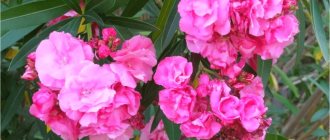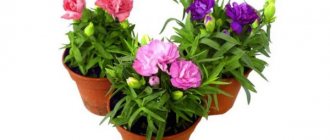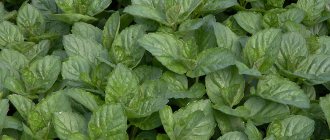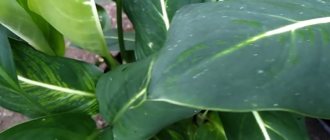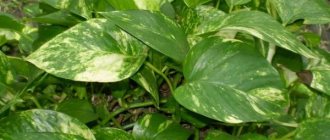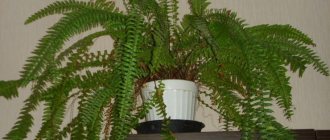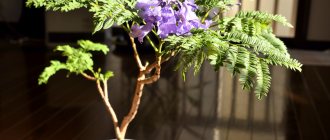Mint is a very healthy and aromatic plant. It is added to tea to calm nerves, improve mood and set the mood for a sweet dream. And if you just touch the mint leaves, the space will be filled with a wonderful aroma. Therefore, many people want to know whether it is possible to grow mint on a windowsill (especially in winter), and how to do it. Naturally, for this you need to have information about the basic rules for planting and caring for a plant at home.
You will learn further about how to plant and grow mint at home on a windowsill.
Pot and soil
The size of the pot depends on how much mint you want to grow. The minimum size is 15 cm, the average is 30-35 cm. The pot should not be deep, because the mint roots are located very close to the surface. Make sure there are drainage holes at the bottom.
For successful growth and development of mint, you need loose, fertile, well-drained soil. The soil for growing mint at home should have a slightly acidic pH between 6.5 and 7.0.
To limit the plant's rapid growth, ensure that mint stems do not fall or touch the ground, as they take root very quickly.
Mint varieties for growing on a windowsill or balcony
Mint is a picky plant; almost any type can be grown at home.
Mint in a pot
The following varieties are often planted in pots:
- Pearl is a medium-sized bush with wrinkled dark leaves. The smell differs from other varieties with spicy notes;
- Pennyroyal is a small bush that grows quickly. The leaves are small in size, grow densely and compactly, and have an intense aroma;
- Fun. This variety is called vegetable mint and has the appearance of a small branched bush. The aroma is cooling, has a pronounced menthol flavor;
- Strawberry mint is a garden variety that does well in a pot. Combines aromas of mint and ripe strawberries, sometimes with chocolate notes;
- Ceremony. Leaves with a textured surface are dark green. The central stem is well developed; if you do not pinch it, mint grows quickly in height;
- Kubanskaya is a variety of peppermint that grows equally well in the garden and in a pot. It is characterized by a high content of essential oil in the leaves and a pungent odor;
- Lemon mint, another name is lemon balm. It takes root well in apartments and has a complex scent of mint with a hint of lemon. More susceptible to fungal diseases than other varieties, does not like excess moisture;
- Flea mint is a low-growing heat-loving plant whose leaves are used in cooking as a seasoning. Contains a large amount of essential oils. If you place it on the balcony in summer, it will repel insects;
- Plectranthus is called indoor mint and is intended for growing at home. The evergreen plant has a scent that repels moths. A decoction is made from the leaves, which helps cope with respiratory diseases.
Note! If mint grows in a garden plot, you can dig it up in the fall and replant it in a pot. The root system is cleaned of remnants of garden soil and washed with running water.
Varieties for cultivation
There are endless varieties of mint, each with its own special aroma - lemon, pineapple, grapefruit. Some people grow several different varieties in one pot at once, it looks very impressive.
For growing on a windowsill, peppermint varieties with a classic smell are most often chosen:
| "Krasnodarskaya" | |
| "Strawberry" | |
| "Fun" | |
| "Medicinal" | |
| "Moldavian" |
Growing from cuttings
When growing mint using the cutting method, stems from 8 to 10 cm long are cut. The shoots need to stand in water, and planting work can begin after small roots appear. Freshly picked mint from the plot or fresh herbs from the store are suitable as raw materials. How to plant:
- Trim the lower leaves.
- Place the cuttings in water.
- Wait for the roots to appear.
- Place the cuttings in nutrient soil, pre-moistened.
Small root shoots appear after 7-14 days, provided they are in a warm room with sufficient humidity. It is better to plant at a time when the roots have not grown to a great length, so there is less risk of damaging them.
How to grow mint at home on a windowsill
There are three ways to propagate mint: seeds, cuttings and root division. To grow it in an apartment, the first two are suitable.
From seeds
The best time to sow mint is March-April.
How to plant mint from seeds:
- Fill a flat wide container with soil.
- Seeds are sown on the surface of the soil.
- Sprinkle with a thin layer of soil substrate.
- Water with water from a spray bottle.
- Cover the pot with film.
Mint seeds should germinate within 10-15 days (sometimes longer) at room temperature or slightly warmer. Once germinated, the tiny seedlings will be fragile, so be careful when watering. In the phase of two or three true leaves, they are picked into separate pots.
The method of growing mint from seeds takes quite a long time and requires much more attention and care compared to cuttings or dividing roots.
From a cutting (twig)
The best way to quickly grow mint in an apartment is to take cuttings from the varieties that you like best.
- Take mint cuttings (sprigs) about 12-15 cm long from an adult plant and remove the lower leaves.
- Place the stems in a glass filled with water and place on a well-lit windowsill. The mint roots will take several weeks to develop. Be sure to change the water when it starts to get cloudy to keep your plant healthy.
Once the roots have grown, plant the mint in a pot of soil:
- Fill the pot with fertile soil, leaving 2 to 3 cm at the top.
- Make a hole in the ground in the center of the pot so that part of the stem with roots fits there.
- Place the branch in the hole, cover the roots with soil and gently tamp it around.
- Gently pour water at room temperature.
Life hack “How to grow mint at home in a few days” – video
How to plant root cuttings
The long root shoots of mint have dormant buds, so the plant can be propagated by layering. How to do it:
- At the end of summer, choose those that have 2-3 buds and cut them to 12 cm in length.
- Planting material is immersed in moist soil, deepening to 5-6 cm.
- If the buds have awakened on the root and the first shoots have appeared, then after planting the part located above the ground is cut off from the top by 5 cm.
- The first shoots can be expected 2 weeks after planting the cuttings.
Caring for mint at home
Mint has very few needs other than watering and fertile soil. To be honest, this plant is quite difficult to kill. Here are a few conditions necessary for the normal growth and development of mint.
Lighting
Mint can tolerate shade, but it needs a minimum of 3-4 hours of sunlight per day to grow well.
Temperature
This spicy plant loves moderate temperatures: indoors it should be at least 18-21 C during the day and 13-15 C at night.
How to water
Mint prefers moist soil, but don't overwater it. If the top of the soil becomes dry to the touch, only then is watering necessary.
Spray the plant with a spray bottle between waterings or place the pot on a tray filled with water with pebbles.
Top dressing
Spices grown at home do not need to be heavily fertilized, otherwise they will lose their taste. To feed mint, use liquid all-purpose fertilizer when you notice that the plant is weak.
Trimming
Regularly prune long mint branches to encourage more bushy green growth and to maintain the plant's beautiful shape.
Don't let the flowers bloom and pinch them back as soon as you notice them. Flowering dramatically reduces the quality of greenery.
Pests and diseases
Being very aromatic, mint almost never suffers from pests and rarely falls victim to disease.
Mint sometimes develops small orange spots on the undersides of its leaves. In this case, use organic fungicides (products to combat fungal plant diseases) and let the soil dry out between waterings.
In rare cases, mint can be attacked by spider mites, aphids, and powdery mildew.
Possible difficulties of cultivation
How to grow lemon eucalyptus at home
Before you grow mint at home, you need to familiarize yourself with the possible difficulties. Problems may arise when transplanting mint from the garden; in this case, you may accidentally plant a plant infected with diseases and pests. Household varieties are susceptible to diseases and pests, just like garden plants.
Diseases
The main problem is the appearance of rust on the leaves. The disease is fungal in nature and manifests itself in the form of dark red spots on the leaves. Reasons for appearance:
- Excess and stagnation of water, increased humidity in the room;
- Low temperature and frequent drafts;
- Excess nitrogen in the soil.
Affected stems must be cut off, the remaining ones are treated with fungicides. Before use, soak the treated mint leaves for 30 minutes in cold water.
The following fungal diseases are common:
- Powdery mildew. It has the appearance of a white coating on shoots and leaves; it forms in the hot season. Treating the plant with a solution of colloidal sulfur at a 1% concentration will help get rid of the problem;
- Anthracnose and septoria blight appear as brown and brown spots on the leaves. The affected plant is treated 3-4 times with Bordeaux mixture with a concentration of 1%;
- Verticillium - during the disease, the leaves wither and begin to darken at the edges. Fungicides are used to eliminate the disease, but they do not provide a 100% guarantee of solving the problem.
Pests
Despite its intense aroma, mint attracts insects. Some of them grow in the soil and can infect a healthy plant. This problem can arise if mint is planted in garden soil that has not been disinfected before.
Pests on leaves
The main pest is the mint flea beetle, which appears in warm, dry weather. The insect, no larger than 1.5 mm in size, gnaws round holes on the leaves. Similar damage is caused by leaf beetles and green scale insects. Along with the soil, weevils and mint mites can get into the pot.
Mint leaves
A real storehouse of vitamins in the cold season is mint on the windowsill, which even a novice gardener can grow. The fragrant and healthy plant is easy to care for, takes root easily and grows quickly.
Harvesting
You can start harvesting mint leaves once the plant has a few stems about 15-18 cm long. This will take about 2 months if you grow it from seeds, and a few weeks less if you planted sprigs.
The best way to harvest mint is to cut the greens as you need them. Never prune more than one-third of the plant, otherwise it will cause growth to be temporarily stunted.
Now, having received detailed recommendations for growing mint on the windowsill, you can enjoy freshly picked fragrant leaves all year round, even in winter!
How to care for mint on the windowsill after planting and before harvesting
To successfully grow mint on a windowsill in an apartment, you need to properly care for it: maintain the temperature, provide additional light as needed, and also water and spray it.
Important! Mint does not tolerate drafts!
Daylight and temperature
This has already been written about before, but let’s repeat:
- In winter (as well as late autumn and early spring), when there is short daylight, you should definitely add light to the plantings in the morning and evening. The rest of the time, it is optimal to place containers with mint on the south, southwest or southeast windows.
- The temperature should be about +20…+25 degrees.
- If you cannot give the plant full daylight (12-16 hours), then the mint will begin to stretch. This can be compensated by lowering the temperature to +15..+18 degrees, especially in the winter season.
Watering
Mint loves moisture, but the plant should not be overwatered, otherwise it will rot. In addition, it tolerates short-term droughts well.
In summer, watering is required more frequently, but in the winter months you should refrain from frequent irrigation. However, during the heating season, when the air is dried by the radiators, you need to spray the leaves daily with warm room water...
In this case, water for irrigation should be settled and at room temperature.
Idea! To simplify the care of mint on the windowsill, you can add a small amount of hydrogel to the soil. It accumulates moisture and evaporates it for a long period, which allows you to reduce the frequency of watering.
Top dressing
Mint is a fairly unpretentious crop, so it does without fertilizers. The main thing is not to flood it and give plenty of light (be sure to add additional light when daylight hours are short).
Thus, by properly caring for mint, you can achieve excellent results, and then the plant will delight you with its appearance and, of course, its unusual aroma.
Top dressing
To maintain the level of beneficial microelements in the leaves, it is enough to fertilize mint at home once in the summer with an aqueous solution of urea (1 g of fertilizer per 1 liter of water).
During the period of leaf formation in young plants, moderate fertilizing with mineral fertilizers is allowed, the dosage of which indicated on the packaging is reduced several times. It is strongly recommended not to fertilize plants in winter.
Important! Excessive fertilizer provokes a decrease in the beneficial and taste qualities of mint.
Useful properties of indoor mint
Indoor mint is not poisonous, its beneficial properties are extensive - diaphoretic, laxative, pain reliever, in addition, the plant:
- Improves digestion.
- Calms the nervous system.
- Makes breathing easier (chew leaves for nasal congestion).
- Helps in the treatment of gynecological diseases.
- Relieves itching from insect bites (stretch the leaf, apply)
- Treats colds (drink mint tea for throat infections).
- The juice relieves nausea along with pomegranate.
Mint fights moths and harmful insects. They use it as a seasoning and make tea. The essential oil contained in it acts as a sedative.
Mint is harvested after flowering, large leaves are collected, the stems are cut by 1/3 during the day in sunny weather. Then they are washed, wiped and laid out on the surface of the fabric to dry in the oven, outside. Store hermetically sealed.
Contraindications for use by pregnant women, nursing mothers, and children under 12 years of age.
Place mint in the bedroom, it drives away anxiety and relieves fatigue. According to signs, it attracts money into the house.
Preparing seeds and cuttings for planting
It is best to purchase mint seeds at a specialty store. Self-collection of seeds is a labor-intensive and complex process. Even if you manage to collect planting material, the plant will differ from the original version not only in appearance, but also in aroma and taste.
- To make seedlings appear faster, the seeds are soaked.
- As soon as the first shoots hatch, they begin planting in the soil.
- For a week, the container with the seeds is covered with film and put in a warm, dark place.
- After most of the seedlings have appeared, the container is moved to a bright place.
If you plan to grow mint from cuttings, then cut off the upper shoots of an adult plant, 10 centimeters long. The cuttings are first placed in water. As soon as the roots appear (after about 1.5 weeks), you can begin planting in a prepared container with soil.
What should the place be like?
In the apartment, you should choose the most illuminated window sill, preferably on the western or eastern side. Lack of light leads to the elongation of the plant stem and a decrease in the content of essential oils. At the same time, seedlings need to be protected from direct sunlight, which can burn the greenery.
The plant develops well at room temperature from +20 to +25 degrees. The spice loves moist air, so it is recommended to place a container of water nearby.
Where to plant
When choosing a container, you need to take into account the amount of desired harvest. If a few branches are enough, you can use flower pots. To obtain a large harvest, you will need a large container.
The mint root system does not go too deep into the ground, so it diverges close to the surface. It is better to choose shallow containers with a large diameter. Be sure to make holes at the bottom of the pot that will not allow excess liquid to stagnate. Before filling the container with soil, drainage is placed.
What soil to plant in
The soil for mint should be loose, light, fertile, with normal acidity and high aeration. You can buy soil or mix it yourself. Humus, peat and sand are added to the soil from the garden. These components provide additional nutrition to the plant and improve oxygen access to the roots. Then the resulting mixture is calcined in the oven.
The acidity level should be neutral. Low acidity leads to a decrease in the content of essential oils in greens. Increased acidity causes slow plant development.
Several ways to plant mint
The perennial is obtained in several ways - by seeds, cuttings, and dividing the bush.
Seeds
You can buy the seed at a flower shop or prepare it yourself. Place in a container with moist soil to a depth of 0.5 cm, cover with film or glass. They will germinate in 14 days, carefully transplant them into a pot, place them in a cool room, and after 40 days in their usual place of growth. In this case, the harvest will be in 2 months. Young shoots differ slightly in taste.
Cuttings
The easiest and fastest way to reproduce. A 6-8 cm part of the side stem is cut with a sharp knife at an angle of 45 degrees. The bottom two sheets are cleaned. Place the shoot in a glass of water or sand. When roots appear 1.5 cm deep, they are transplanted into the ground.
Dividing the bush
When the bush reaches three years of age, it is dug up and divided into parts. Each one must have shoots, roots, and buds. Plant at a depth of 10 cm, add humus.
Description of indoor mint
Indoor mint (Plectranthus aromaticum) or spur flower is a perennial evergreen herbaceous plant of the Lamiaceae family with oblong, oval, pointed leaves. The flowers are small, pale, collected on the upper shoots in umbrellas or racemes, appearing in summer. The root system is fibrous, the stem is ribbed, smooth or pubescent. The plant is hanging, but some species are classified as shrubs with shoots up to 40 cm and abundant foliage.
If you run your hand over the leaves, a pleasant smell will immediately spread.
